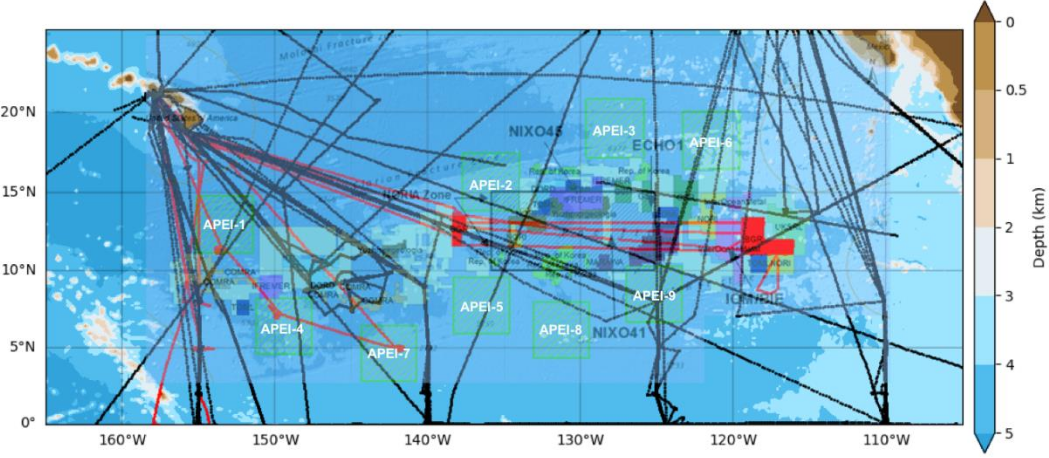The Potential Effects of Deep Sea Mining on Deep Midwater Communities in the CCZ:
Constructing Ecosystem Baselines and Modeling Effects on Ecosystem Services
|
P.F.J. Lermusiaux, P.J. Haley, C. Mirabito, C.S. Kulkarni MIT MSEAS |
T. Peacock, C.M. Royo, R. Ouillon MIT ENDLab |
J.C. Drazen, J. Perelman Univ. of Hawaii-Manoa |
Project Summary Ongoing MIT-MSEAS Research Project Supported publications Additional Project Links Background Information |

|
|
Center for Ocean Engineering
Mechanical Engineering Cambridge, Massachusetts
|
||||
This research is sponsored by the Benioff Foundation.
Project Summary
Understanding the scale of deep-sea mining’s effects is paramount to understand their ecosystem consequences. There is no doubt that deep-sea mining will kill organisms and permanently alter habitats (Drazen et al., submitted). Seafloor disturbance studies clearly show that benthic communities don’t fully recover even after several decades (Jones et al., 2017). Further, much of the fauna relies on the nodules themselves (Amon et al., 2016; Vanreusel et al., 2016) which take millions of years to form. These effects over hundreds of meters to a few kilometers may not comprise a substantial ecosystem impact given the scale of abyssal habitats, but effects over hundreds to thousands of kilometers would surely be defined as serious environmental harm (Levin et al., 2016). Thus the spatial and temporal scales of mining impacts will decide policies and decisions about deep-sea mining activities. There is a clear need to use sediment plume models to estimate the scale of mining impacts in the midwater realm.
Background information is available below.
| Top of page |
Ongoing MIT-MSEAS Research
Long-Term (Collaborative) MIT-MSEAS Goal:
Our goal is to couple a “far-field” regional hydrodynamic model that incorporates a “near-field” sediment plume dynamics model with relevant midwater mining scenarios to midwater biology.
Specific Objectives:
- Assemble and use a bioacoustics (ship mounted ADCP) database from ship transits and opportunistically collected data to build a baseline of mesopelagic biomass and vertical migration behaviors across the CCZ before mining occurs
- Extract the water column integrated intensity and main depth of daytime and nighttime midwater biomass to assess spatial and temporal distributions across the CCZ
- Incorporate biology and ecosystem services into dynamic sediment plume modeling
- Extrapolate potential taxa based effects to determine the extent of the effects on regional ecosystem services
Publications
Project Supported publications
| Top of page |
Additional Project Links
| Top of page |
Background Information
The potential for deep-sea mineral resource exploitation has expanded greatly in the last decade due to a combination of technological feasibility in access, growing metals demand, and problems with terrestrial resource exploitation. The Clarion Clipperton Zone (CCZ) in the eastern north Pacific hosts the greatest number and coverage of exploration licenses on the high seas (17 of 29; www.isa.org.jm). Nearly all environmental research has focused on the seafloor where the most direct effects will occur (Amon et al., 2017; Jones et al., 2017; Van Dover et al., 2017; Wedding et al., 2015). However, sediment plumes and other impacts (e.g., noise) from seafloor mining are likely to be extensive in the water column. Nodule extraction technology is still being developed but the most likely scenarios involve hydraulic lifting of the top ~5-25 cm of sediment and nodules off the seafloor and up a riser pipe to a surface ship. There the nodules will be separated from the water and sediment which will then be discharged back into the midwaters at a rate of >50,000 m3 d-1, below the euphotic zone (Oebius et al., 2001). The expected decadal duration of CCZ mining activities and the large sediment discharge volumes mean that sediment plumes will likely extend throughout the water column, albeit with intensity varying by depth (Rzeznik, Flierl & Peacock, to appear). In the deeper portions of the water column where current velocities are low (Gardner et al., 1984; Leitner et al., 2017), fine abyssal sediments may be slow to settle, potentially spreading in currently unknown concentrations over hundreds of kilometers from the discharge point (Wedding et al., 2015). Clearly environmental research should extend into the midwater realm.
| Top of page |


